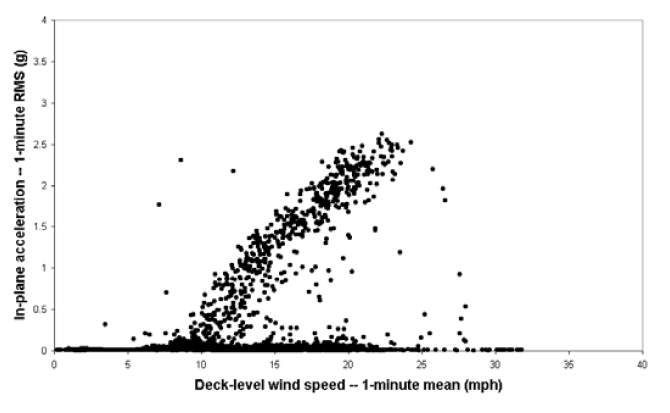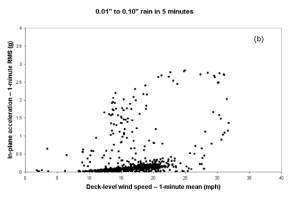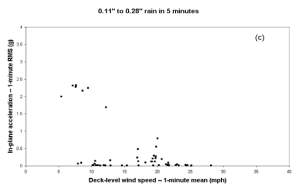Cable Vibration Effect of Cable-Stayed Bridge due to Wind and Rain
| ✅ Paper Type: Free Essay | ✅ Subject: Engineering |
| ✅ Wordcount: 2098 words | ✅ Published: 18 May 2020 |
Cable Vibration Effect of Cable-Stayed Bridge due to Wind and Rain
- Abstract
Cable stayed bridges around the world are usually experiencing excessive and unexpected vibrations of the main stays, often related to the synchronal occurrence of wind and rain. These large amplitude vibrations have become significant considerations because they induce excessive and unexpected stresses and fatigue in the cables themselves and in the connections at the bridge deck and tower [1]. This final report will represent how the wind and rain affect the cable vibration of cable-stayed bridge and its relationship.
- Introduction
Vibrations of cable-stayed bridges become harmful when a predominant excitation frequency is in the vicinity of a natural frequency of the structural system or structural members such as stay cables, which can vibrate with the deck and the tower or independently from the main bridge. Wind, rain are loads that contain a broad spectrum of excitation frequencies and cause large dynamic amplification of the structural response, especially in these low-damped structures. It is generally accepted that wind, rain or wind-rain conditions must be present for inducing large-amplitude cable motion [2].
The current understanding of the nature of these problematic vibrations and the environmental factors that induce them is based on a limited number of field observations. Typical amplitudes and frequencies of vibration have been reported; the vital role of rainfall in inducing vibration has additionally been reported, along with recommended correlations with wind speed and wind direction. However, these observations have not always been in agreement. Early reports suggested that the vibrations occur only during rainfall [3], while subsequent observations on other bridges have revealed vibrations of significant amplitude with no rain [4]. There is also some confusion about the importance of wind direction in inducing vibrations. Early reports indicated that only the cables that declined in the direction of the wind were excited [3], while instances have been reported subsequently of simultaneous vibration of stays with opposite inclination to the wind [4].
Under favorable conditions such as wind at moderate speeds, wind direction at an angle concerning the cable or the cable declined in the wind direction, streams form in the upper and lower surfaces of the cable. The streams change the aerodynamic shape of an otherwise circular cable cross-section, thereby causing aerodynamic instability similar to the one caused in galloping. As the cable oscillates the streams change location, creating oscillatory aerodynamic forces acting on the cable that keep feeding energy to the oscillations [5].
The Fred Hartman Bridge, a cable-stayed bridge, has become a significant architectural landmark in the U.S. state of Texas spanning the Houston Ship Channel. The bridge carries 2.6 miles of State Highway 146, between the cities of Baytown and La Porte. It has two independent steel-girder decks supported by four 436 ft A-shaped towers and 192 steel-stranded stay-cables. Some of the widest decks on any cable-stayed bridge in the world at 78 ft in width are supported by the bridge and see almost 200,000 vehicles cross them per day. The cables, in a fan-type of the arrangement, support a main-span bridge length of 1250 ft and a total span length of 2475 ft [5].

Figure 1
- Content
This paper presents statistics computed from approximately 2700 five-minute records generated during the first year of monitoring, before the installation of a temporary restraining system [1]. We will focus on the correlation of cable acceleration with wind speed, wind direction, and rainfall.
The instrumentation system includes the following primary components: 2 three-axis anemometers at deck level, Propeller-vane anemometer at tower top, 19 two-axis accelerometers installed on stay cables (±4g range), 4 displacement transducers installed on stays, 5 two-axis accelerometers installed on the bridge deck (±4g range), 2 rain gauges (0.01″ resolution) [1].
One-minute root-mean-square (RMS) values are presented for cable acceleration, as a measure of vibration amplitude. The two parts of acceleration are measured on every stay: in-plane and lateral. The range of the accelerometers is ±4g, and in some cases of high-amplitude vibration, the 4g level is sometimes exceeded. The consequence of this is that the RMS statistic is underestimated for the particular record [1].
One-minute mean values are presented for wind speed and wind direction, generated from the three anemometers according to the following priority scheme. Data from the tower-top anemometer are given priority because the tower-top anemometer is not influenced by interference from the bridge towers. The two deck-level gauges were found to be well related to the tower-top anemometer apart from winds nearly parallel to the bridge axis, where interference from the towers seems to reduce the measured velocities at deck-level. Consequently, data from the deck-level anemometers are used only when data from the tower top are unavailable, and then only in the range of wind direction where the correlation with the tower-top anemometer is good. In every case, deck-level wind speeds are presented, and in cases where data from the tower-top anemometer are presented, these values are scaled down to deck-level using a scale factor of 0.675, generated from a linear regression analysis of the deck-level and tower-top data. Wind direction is measured in degrees clockwise from the bridge axis, with zero degrees corresponding to wind approximately from the north, directly along the bridge axis [1].
3.1 Influence of Wind Speed and Wind Direction
Figures 2 shows typical plots of in-plane vibration amplitude vs. wind speed. The responses appear to be velocity-limited, as previously reported [6]. For the stays examined here, the bulk of large-amplitude responses falls in a wind speed range with a lower limit of around 10 mph and an upper limit of 24-33 mph; the precise limits vary from each stay. A few high-amplitude events at lower wind speeds are evident in the figure below, outside the main cluster of high-amplitude responses. Wind speeds did not reach sufficient levels to witness large-amplitude vibrations observed at very high wind speeds by Matsumoto et al. [7]. A general trend of increasing vibration amplitude with wind speed is evident [1].

Figure 2
Figures 3 shows typical plots of in-plane RMS acceleration vs. wind direction. The stay declines to the north. As a wind direction of zero degrees corresponds to wind from the north, and 90 degrees corresponds to wind from the east, it is evident that most of the large amplitude responses occur for wind directions wherever the cable declines within the direction of the wind. This agrees with the report of Hikami and Shiraishi [3]. However, a significant number of lower amplitude responses and even a few large-amplitude responses are evident at other wind directions, as reported by Matsumoto et al. [6]. The large-amplitude responses at other wind directions are mostly associated with instances of very heavy rainfall. Examination of the influence of rainfall allows the separation of the responses into distinct regimes [1].

Figure 3
3.2 Influence of Rainfall
Ohshima and Nanjo previously investigated the influence of rainfall rate on vibration response in the wind tunnel, identifying two response types: heavy rain vibrations and light rain vibrations [8]. Although the characteristics observed in the field are not the same as those observed in the wind tunnel, this approach of grouping responses by the rate of rainfall proves helpful [1].
Figure 4a, 4b, 4c present plots of vibration amplitude of the for different rates of rainfall: no rain, moderate rain, and heavy rain. As the resolution of the rain gauges is limited to 0.01″, some records collected during very light rainfall may not record rainfall during the 5-minute period. These data files were identified by finding measured rain within the close records on that day and eliminating them from the “no-rain” data information. The data presented in Figure 4a, labeled “no rain”, correspond to records collected on days in which no rain was detected in any record [1].
3.2.1 No rainfall regime
Under no-rain conditions, the vibration amplitudes are relatively small and occur at relatively low wind speeds (Figure 4a). The data presented here are from a stay, which exhibits modest vibration levels even without rainfall – some data points here are in excess of 1g RMS acceleration. Other stays show much lower vibration levels without rain. The observed vibrations do appear to be velocity-restricted, but this is difficult to confirm. The responses occur over a broad range of wind directions, mostly where the stay inclines in the direction of the wind (Figure 5a).


Figure 4a Figure 5a
3.2.2 Moderate rain regime
This regime accounts for the bulk of the high amplitude responses, and the characteristics are most similar to those previously reported. The high amplitude responses in this regime are velocity restricted (Figure 4b) and span a narrow range of wind directions, where the stay declines in the direction of the wind (Figure 5b) [1].


Figure 4b Figure 5b
3.2.3 Heavy rain regime
Under heavy-rain conditions, large amplitude vibrations are observed at quite low mean wind speeds (Figure 4c). A relatively small number of data files were recorded with such high rates of rainfall, but in those files that were recorded, nearly all of the instrumented stays were vibrating simultaneously with large amplitudes. These large amplitude events occurred during gusty wind, with a rapidly changing direction, so the dependence on wind direction does not seem important, or the relationship is not clear at this time (Figure 5c) [1].


Figure 4c Figure 5c
- Conclusion
From the Hartman Bridge data, three distinct regimes of cable vibration have been identified from the full-scale measurements: no-rain vibrations, moderate-rain vibrations, and heavy-rain vibrations. These response regimes exhibit different dependence on wind speed and wind direction, and different acceleration orbits. Relatively low levels of vibration were evident in the absence of rainfall. The bulk of the high-amplitude responses were associated with moderate rain, and the characteristics of these events were similar to those previously reported. High-amplitude vibrations related to very heavy rainfall were observed at comparatively low wind speeds. The observed motions exhibit significant two-dimensionality and participation of numerous cable modes, particularly during heavy rain [1].
- References
[1] J.A.Main & N.P.Jones,2014, Full-scale measurements of stay cable vibration, Department of Civil Engineering, Johns Hopkins University, Baltimore, MD, USA, National Institute of Standards and Technology.
[2] Ahmed M. Abdel-Ghaffar,1 Member, ASCE and Magdi A. Khalifa,1991, IMPORTANCE OF CABLE VIBRATION IN DYNAMICS OF CABLE-STAYED BRIDGES. Eng. Mech., 117(11): 2571-2589
[3] Hikami, Y. & Shiraishi, N. 1988. Rain-wind induced vibrations of cables in cable stayed bridges. J Wind Eng Indust Aero. 29: 409-418.
[4] Matsumoto, M., Shiraishi, N. & Shirato, H. 1990. Aerodynamic behavior of inclined circular cylinders–cable aerodynamics. J Wind Eng Indust Aero. 33: 63-72.
[5] Aaron James Pebley, 2005, Bending Stresses in Stay-Cables During Large-Amplitude Vibrations – A Fred Hartman Bridge Case Study, The University of Texas at Austin.
[6] Matsumoto, M., Shirato, H., Saito, T., Kitazawa, M. & Nishizaki, T. 1995. Response characteristics of rain-wind induced vibration of stay-cables of cable-stayed bridges. J Wind Eng Indust Aero. 57: 323-333.
[7] Matsumoto, M., Daito, Y., Kanamura, T., Shigemura, Y., Sakuma, S. & Ishizaki, H. 1997. Wind-induced vibration of cables of cable-stayed bridges. Proc. 2nd EACWE. 1791- 1798
[8] Ohshima, K. & Nanjo, M. 1987. Aerodynamic stability of the cables of a cable-stayed bridge subject to rain (a case study of the Aji River Bridge). Proc. U.S.-Japan Joint Seminar on Natural Resources.
Cite This Work
To export a reference to this article please select a referencing stye below:
Related Services
View allDMCA / Removal Request
If you are the original writer of this essay and no longer wish to have your work published on UKEssays.com then please click the following link to email our support team:
Request essay removal



